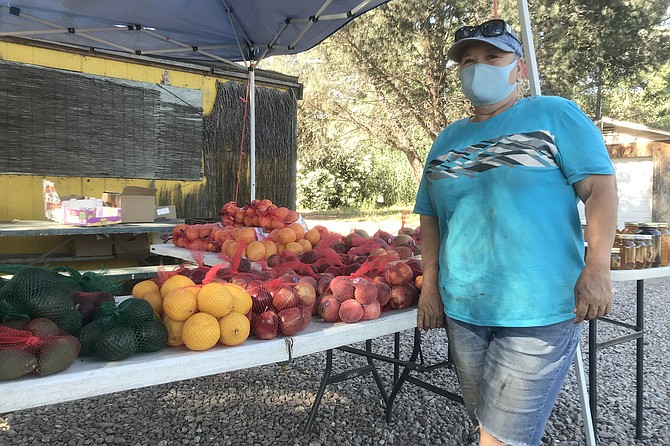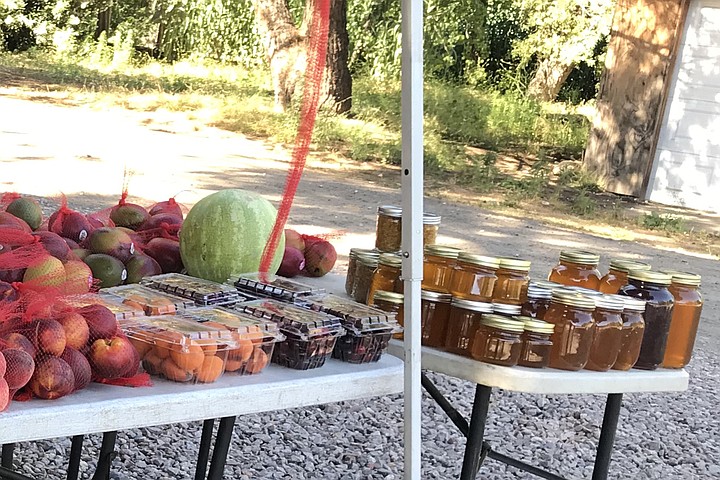 Facebook
Facebook
 X
X
 Instagram
Instagram
 TikTok
TikTok
 Youtube
Youtube

To bee, or not to bee? That is the question in bucolic Harbison Canyon. I have just made an eye-popping discovery about the Canyon — sandwiched between east El Cjaon and Alpine — and it ain’t some nudist colony’s Open Day.
It’s more about bee colonies.
Back in the day, it turns out, this was the world’s #1 sweet spot for honey.
I was buying a $10 jar of dark honey at this roadside stall, just where the Canyon starts tumbling east towards Alpine. While I was waiting for change, I looked up “Harbison Canyon” on my iPad, and came across this entry for “John Stewart Harbison.”
“In the spring of 1874, [Harbison] moved with his wife and daughter to a homestead near the Sweetwater River, 23 miles east of San Diego, in a little valley now known as Harbison Canyon. Within seven years’ time, he was the largest producer of honey in the world, operating 2000 to 3000 hives.”
Say what? “In the world?”

Carol Morrison, the archivist at the Alpine Historical Society, says Harbison’s honey did indeed span the world.
“There’s one story that I heard that Queen Victoria in England tasted some of Alpine’s honey. I’m very proud of that fact.”
She says that with the nearby Alpine area at a higher altitude, and Lakeside at a lower altitude, Harbison Canyon was in the sweet spot. “You have different plants growing in different altitudes. Sage, buckwheat, manzanita: bees can range for seven miles, so they have the opportunity to collect nectar from a variety of different plants.”
John Harbison was the son of a beekeeper, born in Pennsylvania. He came out to California for the gold rush. “He discovered that he could make more money selling hives and bees than from gold,” says Morrison.
His innovative spirit — he was always designing new hives — and knowledge of bees meshed perfectly with history. The transcontinental railroad link was secure, so he could easily export his honey to the east coast. And beyond. And speed isn’t important with honey. It is pure sugar and doesn’t need preservatives. They say it can last for centuries.

What did Harbison’s honey taste like? “I buy my honey from a man in Lakeside,” says Morrison, “and his honey is much stronger-tasting. Store-bought honey is just sweet. This has a flavor like buckwheat. It takes a while to get used to it, but it’s excellent. Put it in your oatmeal, throw in a handful of blueberries, and it’s absolutely wonderful.”
So what happened? How come Harbison bees aren’t still honeymakers to the world?
Disease and pesticides, says Jaime Garza, from the County’s Department of Agriculture. “They caused a 34 percent loss in managed bee colonies last year. It’s not catastrophic, just means more work raising queens for bee growers.”
But mostly, you can probably blame the lemon growers, who invaded the area during the last century, for squeezing bees out.
Or are the honey moneymakers still buzzing discreetly around Harbison Canyon? According to Garza, we may never know, because it turns out beekeepers are cagey about the deals they do with landowners to set up their hives. They find places with the right sort of plants to feed their bees, to help the little buzzers create honey with the most vitamins and best flavors, and that becomes their closely-guarded secret.
“Go ask them,” he says. Then he adds, “Good luck.”


To bee, or not to bee? That is the question in bucolic Harbison Canyon. I have just made an eye-popping discovery about the Canyon — sandwiched between east El Cjaon and Alpine — and it ain’t some nudist colony’s Open Day.
It’s more about bee colonies.
Back in the day, it turns out, this was the world’s #1 sweet spot for honey.
I was buying a $10 jar of dark honey at this roadside stall, just where the Canyon starts tumbling east towards Alpine. While I was waiting for change, I looked up “Harbison Canyon” on my iPad, and came across this entry for “John Stewart Harbison.”
“In the spring of 1874, [Harbison] moved with his wife and daughter to a homestead near the Sweetwater River, 23 miles east of San Diego, in a little valley now known as Harbison Canyon. Within seven years’ time, he was the largest producer of honey in the world, operating 2000 to 3000 hives.”
Say what? “In the world?”

Carol Morrison, the archivist at the Alpine Historical Society, says Harbison’s honey did indeed span the world.
“There’s one story that I heard that Queen Victoria in England tasted some of Alpine’s honey. I’m very proud of that fact.”
She says that with the nearby Alpine area at a higher altitude, and Lakeside at a lower altitude, Harbison Canyon was in the sweet spot. “You have different plants growing in different altitudes. Sage, buckwheat, manzanita: bees can range for seven miles, so they have the opportunity to collect nectar from a variety of different plants.”
John Harbison was the son of a beekeeper, born in Pennsylvania. He came out to California for the gold rush. “He discovered that he could make more money selling hives and bees than from gold,” says Morrison.
His innovative spirit — he was always designing new hives — and knowledge of bees meshed perfectly with history. The transcontinental railroad link was secure, so he could easily export his honey to the east coast. And beyond. And speed isn’t important with honey. It is pure sugar and doesn’t need preservatives. They say it can last for centuries.

What did Harbison’s honey taste like? “I buy my honey from a man in Lakeside,” says Morrison, “and his honey is much stronger-tasting. Store-bought honey is just sweet. This has a flavor like buckwheat. It takes a while to get used to it, but it’s excellent. Put it in your oatmeal, throw in a handful of blueberries, and it’s absolutely wonderful.”
So what happened? How come Harbison bees aren’t still honeymakers to the world?
Disease and pesticides, says Jaime Garza, from the County’s Department of Agriculture. “They caused a 34 percent loss in managed bee colonies last year. It’s not catastrophic, just means more work raising queens for bee growers.”
But mostly, you can probably blame the lemon growers, who invaded the area during the last century, for squeezing bees out.
Or are the honey moneymakers still buzzing discreetly around Harbison Canyon? According to Garza, we may never know, because it turns out beekeepers are cagey about the deals they do with landowners to set up their hives. They find places with the right sort of plants to feed their bees, to help the little buzzers create honey with the most vitamins and best flavors, and that becomes their closely-guarded secret.
“Go ask them,” he says. Then he adds, “Good luck.”
Comments